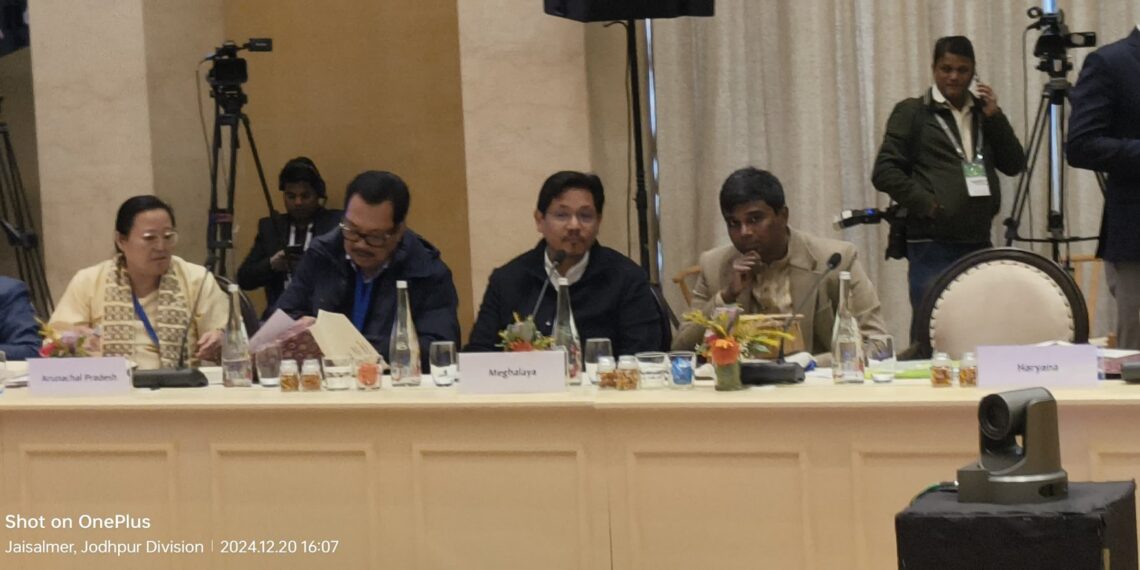Shillong: In a bid to tackle Meghalaya’s pressing development needs, Chief Minister Conrad K Sangma has urged the central government to allocate more than Rs 1.5 lakh crore.
This appeal was made during pre-budget consultations with Union Finance Minister Nirmala Sitharaman in Jaisalmer, Rajasthan.
The proposed measures are designed to strengthen infrastructure, expand digital services, improve rural livelihoods, and boost financial inclusion in the state.
Sangma emphasised the transformative potential of strategic investments by the Finance Ministry in areas such as SASCI funding, tailored allocations for northeastern states, digital service centres, rural banking initiatives, and urban infrastructure.
Sangma called for the continuation and expansion of the Special Assistance to States for Capital Investment (SASCI) scheme, suggesting an allocation of over Rs 1.5 lakh crore for the fiscal year 2025-26.
He noted that the scheme has been pivotal in enabling northeastern states to execute crucial capital projects that enhance economic growth and improve quality of life.
Meghalaya’s utilisation of SASCI funds has been instrumental in bridging resource gaps and improving connectivity, making the program’s extension essential.
ALSO READ: Meghalaya Court pushes for timely development of Shillong Airport to enhance connectivity
To address the unique hurdles faced by northeastern states, Sangma proposed a dedicated allocation of Rs 10,000 crore under the SASCI framework for seven states in the region, excluding Assam.
High infrastructure costs—35% to 50% more than in other areas—pose significant challenges.
This additional funding would enable these states to participate fully in India’s growth trajectory and boost human development indices.
To address digital service delivery challenges, Sangma proposed setting up 1,000 Citizen Digital Service Delivery Centres (CDSDCs) throughout Meghalaya.
These centres would provide critical services, including welfare programs, banking, healthcare, and education, particularly in remote and digitally underserved areas.
Sangma highlighted the initiative’s role in bridging the digital divide, ensuring that even marginalised communities can access government services and acquire essential digital skills.
Highlighting the need for safe and resourceful spaces for women-led Self-Help Groups (SHGs), Sangma proposed constructing 1,000 Village Organization (VO) service delivery centres under the SASCI scheme.
These facilities would support entrepreneurial endeavours and extend the benefits of initiatives like Working Women Hostels to rural areas, fostering economic growth through women’s active participation.
Sangma also suggested increasing the loan limit for SHGs from Rs 3 lakh to Rs 5 lakh to facilitate business expansion.
ALSO READ: Meghalaya expresses disappointment over stalled border talks with Assam
Furthermore, he recommended a 3% interest subvention on timely loan repayments to encourage greater SHG participation, akin to the Kisan Credit Card model.
The Chief Minister highlighted the lack of adequate banking infrastructure in rural Meghalaya.
To address this, he proposed increasing the number of single-person rural bank branches, doubling the rural branch network, and incentivising Business Correspondents (BCs) based on transaction volumes.
Sangma also suggested financial support through viability gap funding (VGF) or the Financial Inclusion Fund (FIF) to ensure sustainable rural banking operations.
Sangma pointed out the limited impact of urban schemes such as AMRUT and AMRUT 2.0 in Meghalaya.
Despite adjustments to eligibility criteria, northeastern states receive only 2.68% of the total Rs 66,750 crore under AMRUT 2.0, a figure that drops to 1.52% without Assam.
Sangma proposed increasing this allocation and creating a dedicated budget for northeastern and hilly cities to tackle their distinct urban infrastructure needs.
Under the Jal Jeevan Mission, Sangma suggested a 50-50 cost-sharing mechanism for operation and maintenance expenses over two to three years.
This collaborative approach would address Meghalaya’s fiscal challenges while ensuring sustainable rural water supply systems.
Central support would help alleviate the state’s financial burden, safeguard infrastructure investments, and empower communities to manage water systems effectively.
ALSO READ: Meghalaya CM launches film grant guidelines to provide financial aid to filmmakers
Sangma reiterated the importance of meeting the mission’s goal of providing tap water connections to every rural household by 2024.
The chief minister’s proposals underscore a comprehensive approach to addressing Meghalaya’s developmental challenges.
By focusing on SASCI funding, digital and financial inclusion, rural livelihoods, and infrastructure development, the state aims to achieve significant socio-economic progress and align with India’s broader growth objectives.















